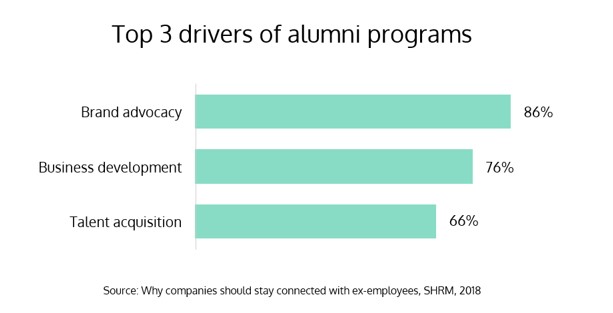The Power of Corporate Alumni Networks

When a valued employee hands in their resignation, don’t write them off just yet. Proactive organisations recognise the value of nurturing relationships with former employees long after they depart the organisation. In fact, by investing in long-lasting relationship building, your employees will never really leave you.
Corporate alumni networks are a great way for organisations to stay connected to ex-employees. They are most prevalent in large, global companies: it’s been found that 98% of Fortune 500 have some form of alumni program where valued ex-employees and their networks can connect via smart online platforms.
Alumni program offerings differ between organisations, but Deloitte is a famous example of an organisation that commits to engaging its far-flung alumni (or, as they are known, “colleagues for life”) through its LinkedIn group. Members and subscribers benefit from networking opportunities, newsletter updates, training sessions, resume writing, referral schemes and company event invitations. Bells and whistles aside, the goal of alumni networks is the same for all: to engage former employees, cultivate new ventures, increase brand advocacy, leverage expertise and create talent opportunities.
Developing an alumni network is an effective way to keep employees feeling positive about their former employer. Alums can be many things: brand ambassadors, employee referrers, rehires, future business partners/clients, and buyers of products and services. Indeed, many organisations are finding many benefits to strengthening ties.
One study uncovered the motivation behind developing alumni programs:

Let’s look at the benefits more closely.
Return employees and referral sources
Enhancing talent acquisition efforts is a common rationale behind the decision to develop an alumni network. It enables organisations to create a pool of attractive talent with a proven success rate in the company who can be “re-recruited” after some time away. These employees are known as “boomerang employees” or “comeback colleagues”. Alumni are also a source of referrals and can help an organisation grow its talent pool. In some cases, alums are compensated for referring a successful candidate and helping to shortcut the vetting candidate process. A lot of this depends on brand advocacy, which is something alumni networks cultivate.
Intellectual capital and ROI
From the perspective of HR teams and hiring managers, who spend large amounts of money, resources and energy enticing new talent into their ranks, having the opportunity to rehire is attractive because it’s more cost-effective. Additionally, because rehires are known, the likelihood of a costly poor hire is reduced. In fact, ELMO’s 2020 HR Benchmark Report found that the average cost to hire a new employee in Australia and New Zealand is $10,500.
Return employees are valuable because they are suppliers of intellectual capital: they bring with them a wealth of new knowledge, insight and motivation, and typically perform at a higher level and reach full productivity quicker than their “brand new” counterparts.
Indeed, the cost of maintaining alumni programs via online social networking channels is low, while tapping into an alumni network can have a high ROI. Organisations who brand departed employees as being of little value – or, worse, as traitors – must reconsider their stance. Employers should try to ensure that all departing employees are given a positive lasting impression of the organisation, and that the door to them stays open. Turning “goodbye” into “we will see you later” will forge a competitive edge.
Brand ambassadors and lobbyists
Organisations must not underestimate the influence former employees have on an organisation. They have the power to shape a narrative around an organisation – for better or worse – through word-of-mouth or via social networking. Alumni networks convert employees into brand ambassadors and lobbyists, who will actively spout positive opinions about the organisation and fortify its reputation and brand image. In some instances, alums are leaned upon to test the effectiveness of marketing campaigns or even try out new products. The more engaged the network is, the more an organisation can leverage brand loyalty.
Developing an alumni network: where to begin
Developing an alumni network from the ground-up can be a time-consuming task, requiring the gathering and dissecting of large quantities of information. But with the help of technology to automate such tasks, the process can be pain-free and cost-effective.
So, what principles are successful alumni networks built on?
An empowering exit
The key to building alumni networks that work is to put the wheels in motion the moment a valued employee hands in their notice. Conduct an exit interview to capture information such as sentiment, the reason behind the departure, and any feedback they may have about the organisation. Following this, the employer must communicate to them the value of joining the alumni network – in other words, why they should stay in touch with the organisation. In fact, offering access to an alumni network is a great offboarding tactic and encourages employee productivity right until the last day of employment. Ultimately, employers must treat an employee’s decision to leave not as an ending, but as an opportunity to engage them long-term.
Two-way communication
If a trust-filled employer-employee relationship is to be perpetuated, information sharing must be two-way. An organisation cannot expect former employees to remain engaged and share updates on what they are doing if the organisation does not hold up their end of the bargain. There needs to be enough to keep former employees engaged and actively participating in the organisation’s community, which is why many organisations distribute newsletters talking about company updates, subsidised training programs, and invitations to company events. Expecting alumni to be willing participants in an alumni program that is lacklustre is naïve – hence, it must provide value.
Personalisation
Providing a personalised experience is key to maintaining engagement. Consider the audience when sharing information, as some groups will relate while others won’t. For example, alums based overseas won’t want to hear about events happening in Australia. Similarly, retirees don’t want to see information about graduate opportunities. Whatever platform you are using, ensure content is targeted, or that different groups are created to reflect varying demands.
Inclusivity
A successful alumni network is one that includes individuals from across the corporate community. Excluding certain alums based on their job title, rank or geography does not send a positive message.
Getting started
First thing’s first: choose a platform. LinkedIn and Facebook are great for organisations that have little or no budget to invest in flashy alumni programs, as they are free and easy to manage. Simply add alums into a group and post regularly. Organisations that have a little more to spend – or perhaps have a large alumni network – may choose to build a dedicated website where content, news updates and discussion boards are housed.
Other tips and tricks for getting a prosperous alumni network off the ground are as follows:
- Assign a dedicated alumni network manager and moderator to manage feedback and post content (e.g. a weekly/monthly/quarterly company newsletter or an alumnus “wall of fame”)
- Strategise alumni groups – will there be different groups for ex-employees vs. contractors and interns?
- Update the exit process to ensure employees receive a positive “goodbye”
- Create a candidate referral program for alumni to use
- Host alumni events
When an employee leaves, the book is not closed. An alumni network can help you keep your (revolving) door open, so you can continue to leverage your most valued employees long after their employment ends.
ELMO Cloud HR & Payroll can help HR professionals manage their workforce, even while operating remotely. As a cloud-based solution, ELMO helps employers manage their teams from anywhere at any time from a secure, centralised location. All employee-employer touchpoints are covered by ELMO’s suite, from ‘hire to retire’. For further information on any ELMO solution, please contact us.
 HR Core
HR Core 









